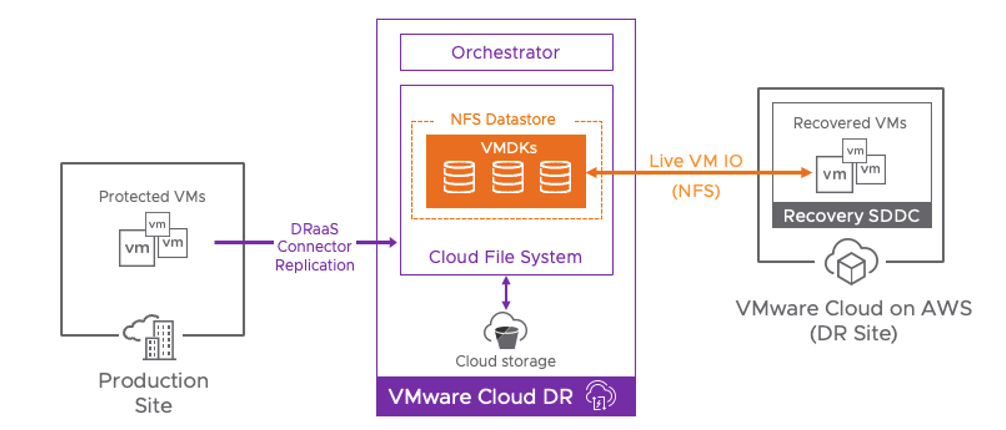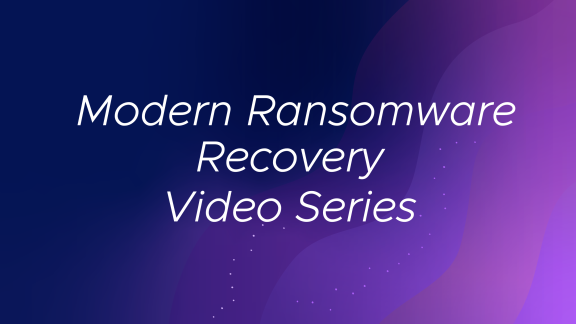Ransomware and Disaster Recovery readiness continue to be a top priority for CIOs around the globe, and for a good reason—ransomware attacks are skyrocketing, compliance requirements are driving organizations to implement recovery measures, and the risk of not having a recovery solution in place is just too high. VMware continues to deliver on enterprise-ready capabilities to support the needs of the modern business with new features in VMware Cloud DR and VMware Ransomware Recovery that will increase confidence and minimize time to recovery.
Enterprise-Ready Recovery with VMware Cloud DR: Faster Failover and Failback, Improved TCO
Until now, when customers were in a DR scenario, they had the single option to power-on recovered VMs in the DR SDDC through Instant Power On with their disks residing on the Cloud Filesystem. These were then migrated to primary storage in the DR SDDC via storage vMotion.
Though this is still the recommended approach for I/O intensive or large workloads, users can now benefit from enhanced recovery performance with a new feature: Run Recovered VMs on Cloud Filesystem.[1] (for details about how our Cloud Filesystem works, check out this blog by our CTO, Sazzala Reddy).
With this option, the VMs can continue to run in the DR SDDC in this manner with their disks residing in the Cloud Filesystem, avoiding storage vMotion and thus speeding up the failover. Failback time is decreased as there is no longer a need to transfer data from the recovery SDDC and the Cloud Filesystem. VMs running on the Cloud Filesystem will get high availability (HA) protection and benefit from low RPOs.

Key benefits of Run Recovered VMs on Cloud Filesystem include:
- Faster failover and better post-recovery performance: avoid Storage vMotion to vSAN and run recovered VMs with the disks still residing in the Cloud Filesystem.
- Faster failback: this new feature removes the need for VADP-based snapshotting on the recovery SDDC at failback.
- Optimized TCO: for storage-bound workloads, a smaller footprint of cloud hosts is needed to run VMs directly on Cloud Filesystem, compared to a traditional failover.
- Flexibility: choose which workloads to run on the Cloud Filesystem and which ones to storage vMotion to the recovery SDDC.

Multi-Cloud DR Support
In addition, VMware Cloud DR now protects Google Cloud VMware Engine (Generally Available) and AWS Outposts (Tech Preview) workloads. Customers can now protect their workloads running in different clouds against ransomware attacks and other disasters, and restore those workloads back to the original site once recovery operations have been completed.
VMware Ransomware Recovery: Faster, more efficient recovery from modern threats
Introducing Bulk VM Processing for VMware Ransomware Recovery. With this new feature, users benefit from streamlined and automated recovery of up to 50 VMs at a time, speeding up time to recovery and optimizing IT resources. Bulk VM processing operates within the existing guided ransomware recovery workflow, which spans across identification, validation and restore of recovery points. Up to 500 VMs can be included in a single ransomware recovery plan, with concurrent processing being possible on 50 VMs at a time, thus allowing multiple VMs to undergo live behavioral analysis to surface any security alerts, which can be used to cleanse ransomware strains from compromised snapshots. Together, these integrated capabilities deliver more confident, faster restore of operations in the event of a successful ransomware attack.

For additional information about these new features, visit our FAQs and our TechZone page.
To learn more about our Ransomware and Disaster Recovery solution, visit us at:
VMware Ransomware Recovery Webpage
VMware Cloud Disaster Recovery Webpage
[1] Users can run VMs live on the cloud filesystem for up to 30 days




